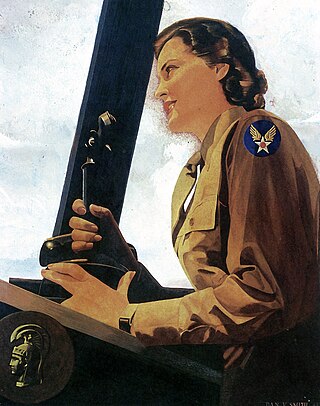
A non-commissioned officer (NCO) is a military officer who does not hold a commission. Non-commissioned officers usually earn their position of authority by promotion through the enlisted ranks. In contrast, commissioned officers usually enter directly from a military academy, officer training corps (OTC) or reserve officer training corps (ROTC), or officer candidate school (OCS) or officer training school (OTS), after receiving a post-secondary degree.
Sergeant (Sgt) is a rank in use by the armed forces of many countries. It is also a police rank in some police services. The alternative spelling, serjeant, is used in The Rifles and other units that draw their heritage from the British light infantry. Its origin is the Latin serviens, 'one who serves', through the Old French term serjant.
Corporal is a military rank in use by the armed forces of many countries. It is also a police rank in some police services. The rank is usually the lowest ranking non-commissioned officer. In some militaries, the rank of corporal nominally corresponds to commanding a section or squad of soldiers.
Staff sergeant is a rank of non-commissioned officer used in the armed forces of many countries. It is also a police rank in some police services.
A master sergeant is the military rank for a senior non-commissioned officer in the armed forces of some countries.
Sergeant major is a senior non-commissioned rank or appointment in many militaries around the world.
Lance corporal is a military rank, used by many English-speaking armed forces worldwide, and also by some police forces and other uniformed organisations. It is below the rank of corporal.
The chart below represents the current enlisted rank insignia of the United States Air Force.
The chart below shows the current enlisted rank insignia of the United States Army, with seniority, and pay grade, increasing from right to left. The enlisted ranks of corporal (E-4) and higher are considered non-commissioned officers (NCOs). The rank of specialist is also in pay grade E-4, but does not hold non-commissioned officer status; it is common that a soldier may never hold the rank of corporal, and instead be promoted from specialist to sergeant, attaining junior NCO status at that time.
Technical sergeant is the name of three current and two former enlisted ranks in the United States Armed Forces, as well as in the U.S. Civil Air Patrol. Outside the United States, it is used only by the Philippine Army, Philippine Air Force, and the Philippine Marine Corps.

The Women's Army Corps (WAC) was the women's branch of the United States Army. It was created as an auxiliary unit, the Women's Army Auxiliary Corps (WAAC) on 15 May 1942, and converted to an active duty status in the Army of the United States as the WAC on 1 July 1943. Its first director was Colonel Oveta Culp Hobby. The WAC was disbanded on 20 October 1978, and all WAC units were integrated with male units.
The term used in the Royal Air Force (RAF) to refer to all ranks below commissioned officer level is other ranks (ORs). It includes warrant officers (WOs), non-commissioned officers (NCOs) and airmen.

The ranks in the Israel Defense Forces (IDF) reflect an individual's level in the military.
Specialist is a military rank in some countries' armed forces. Two branches of the United States Armed Forces use the rank. It is one of the four junior enlisted ranks in the United States Army, above private (PVT), private (PV2), and private first class and is equivalent in pay grade to corporal; in the United States Space Force, four grades of specialist comprise the four junior enlisted ranks below the rank of sergeant.
United States Army commissioned officers rank insignia in use today.

United States Marine Corps rank insignia are the devices worn by officers in the United States Marine Corps, in order to provide distinction from other ranks. Different styles of rank insignia are worn on different uniforms of the United States Marine Corps.

The U.S. Army enlisted rank insignia that was used during World War II differs from the current system. The color scheme used for the insignia's chevron design was defined as golden olive drab chevrons on a dark blue-black wool background for wear on "winter" uniform dress coats and dress shirts or silvery-khaki chevrons on a dark blue-black cotton background for wear on the various types of field jackets and "winter" uniform fatigue shirts. An unauthorized variant that nevertheless saw wide use was olive drab chevrons on a khaki cotton background for wear on the "summer" uniform dress coats and dress shirts. This scheme of rank insignia was established by War Department Circular No. 303 on 5 August 1920 and would see two significant changes in 1942. The usage of this style of insignia was ended by Department of the Army Circular No. 202, dated 7 July 1948, which provided for significant changes in both rank and insignia design.
Technician fourth grade was a rank of the United States Army from 1942 to 1948. The rank was created to recognize enlisted soldiers with special technical skills, but who were not trained as combat leaders.
Technician fifth grade was a rank of the United States Army from 1942 to 1948. The rank was created to recognize enlisted soldiers with special technical skills, but who were not trained as combat leaders.
The United States Public Health Service Commissioned Corps uses the same commissioned officer rank structure as the United States Navy and Coast Guard: from ensign to admiral. While the commissioned corps is authorized to use warrant officer ranks W-1 to W-4 under the U.S. Code of law, it does not currently use these ranks.





